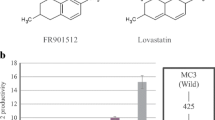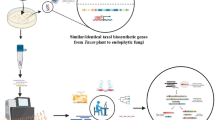Abstract
Tubercularia sp. TF5 is an endophytic fungal strain isolated from the medicinal plant Taxus mairei. Previously, taxol has been detected in the fermentation products of this strain. However, it lost the capability of producing taxol after long-term laboratory culture. Herein, we tried to reactivate the production of taxol by protoplast mutations and genome shuffling. The protoplasts of Tub. sp. TF5 were prepared from its mycelia, and mutated by UV and NTG. The mutant strains regenerated from the mutated protoplasts were selected and classified into four groups on the basis of their phenotypes, the profile of their metabolites analyzed by TLC, MS, and bioassay data. Then, genome shuffling was subsequently carried out with eight mutant strains, with two representatives from each protoplast mutant group, and genome shuffling mutant strains were obtained and screened using the same screening procedure. Although taxol has not been detected in any mutant, two important mutants, M-741 and G-444 were selected for metabolites isolation and determination due to their phenotypes, and differences in TLC analysis result from TF5 and other mutants. Three new sesquiterpenoids, namely tuberculariols A–C (1–3), and a known dihydroisocoumarin (4) were obtained from M-741. Eighteen novel compounds were isolated from G-444, including five new sesquiterpenoids (5-9), two new dihydroisocoumarins (10, 11), one new tetralone (12), together with 10 known compounds (13–20, 1, and 2). The compounds isolated from the M-741 and G-444 were different in structure types and substitutions from those of TF5 (15, 21–29). The results showed, for the first time, that protoplast mutations and genome shuffling are efficient approaches to mining natural products from endophytic fungi. Understanding the mechanisms of unlocking the biosynthesis of new metabolites will facilitate the manipulation of the secondary metabolism in fungi.


Similar content being viewed by others
References
Ting L, Xiang L, Chunhua L, Zhiyu H, Wenyu H et al (2009) Secondary metabolites of Phomopsis sp. XZ-26, an endophytic fungus from Camptotheca acuminate. Eur J Org Chem 2009:2975–2982
Kumaran RS, Hur BK (2009) Screening of species of the endophytic fungus Phomopsis for the production of the anticancer drug taxol. Biotechnol Appl Biochem 54:21–30
Zhang H-W, Song Y-C, Tan R-X (2006) Biology and chemistry of endophytes. Nat Prod Rep 23:753–771
Wang J, Li G, Lu H, Zheng Z, Huang Y et al (2000) Taxol from Tubercularia sp. strain TF5, an endophytic fungus of Taxus mairei. FEMS Microbiol Lett 193:249–253
Li Y, Lu C, Hu Z, Huang Y, Shen Y (2009) Secondary metabolites of Tubercularia sp. TF5, an endophytic fungal strain of Taxus mairei. Nat Prod Res 23:70–76
Patnaik R (2008) Engineering complex phenotypes in industrial strains. Biotechnol Prog 24:38–47
Parekh S, Vinci VA, Strobel RJ (2000) Improvement of microbial strains and fermentation processes. Appl Microbiol Biotechnol 54:287–301
Zhang YX, Perry K, Vinci VA, Powell K, Stemmer WP et al (2002) Genome shuffling leads to rapid phenotypic improvement in bacteria. Nature 415:644–646
Foland TB, Dentler WL, Suprenant KA, Gupta ML Jr, Himes RH (2005) Paclitaxel-induced microtubule stabilization causes mitotic block and apoptotic-like cell death in a paclitaxel-sensitive strain of Saccharomyces cerevisiae. Yeast 22:971–978
Ren X, Ming-Zi W, Chun-Hua L, Zhong-Hui Z, Yue-Mao S (2009) Tuberculariols A–C, new sesquiterpenes from the mutant strain M-741 of Tubercularia sp. TF5. Helv Chim Acta 92:1514–1519
Patnaik R, Louie S, Gavrilovic V, Perry K, Stemmer WP et al (2002) Genome shuffling of Lactobacillus for improved acid tolerance. Nat Biotechnol 20:707–712
Dai M, Copley SD (2004) Genome shuffling improves degradation of the anthropogenic pesticide pentachlorophenol by Sphingobium chlorophenolicum ATCC 39723. Appl Environ Microbiol 70:2391–2397
Hatvani L, Manczinger L, Kredics L, Szekeres A, Antal Z et al (2006) Production of Trichoderma strains with pesticide-polyresistance by mutagenesis and protoplast fusion. Antonie Van Leeuwenhoek 89:387–393
Kevei F, Peberdy JF (1984) Further studies on protoplast fusion and interspecific hybridization within the Aspergillus nidulans group. J Gen Microbiol 130:2229–2236
Wei GH, Liu DP, Liang CC (2004) Charting gene regulatory networks: strategies, challenges and perspectives. Biochem J 381:1–12
Bok JW, Keller NP (2004) LaeA, a regulator of secondary metabolism in Aspergillus spp. Eukaryot Cell 3:527–535
Schardl CL (2006) A global view of metabolites. Chem Biol 13:5–6
Kosalkova K, Garcia-Estrada C, Ullan RV, Godio RP, Feltrer R et al (2009) The global regulator LaeA controls penicillin biosynthesis, pigmentation and sporulation, but not roquefortine C synthesis in Penicillium chrysogenum. Biochimie 91:214–225
Bouhired S, Weber M, Kempf-Sontag A, Keller NP, Hoffmeister D (2007) Accurate prediction of the Aspergillus nidulans terrequinone gene cluster boundaries using the transcriptional regulator LaeA. Fungal Genet Biol 44:1134–1145
Brakhage AA, Schuemann J, Bergmann S, Scherlach K, Schroeckh V et al (2008) Activation of fungal silent gene clusters: a new avenue to drug discovery. Prog Drug Res 66(1):3–12
Smith CA, Woloshuk CP, Robertson D, Payne GA (2007) Silencing of the aflatoxin gene cluster in a diploid strain of Aspergillus flavus is suppressed by ectopic aflR expression. Genetics 176:2077–2086
Wheeler MH, Abramczyk D, Puckhaber LS, Naruse M, Ebizuka Y et al (2008) New biosynthetic step in the melanin pathway of Wangiella (Exophiala) dermatitidis: evidence for 2-Acetyl-1, 3, 6, 8-Tetrahydroxynaphthalene as a novel precursor. Eukaryot Cell 7:1699–1711
Wheeler MH, Bruton BD, Puckhaber LS, Zhang J, Stipanovic RD (2004) Identification of 1, 8-dihydroxynaphthalene melanin in Monosporascus cannonballus and the analysis of hexaketide and pentaketide compounds produced by wild-type and pigmented isolates of the fungus. J Agric Food Chem 52:4113–4120
Bok JW, Balajee SA, Marr KA, Andes D, Nielsen KF et al (2005) LaeA, a regulator of morphogenetic fungal virulence factors. Eukaryot Cell 4:1574–1582
Acknowledgments
We are grateful to Prof. Himes at the University of Kansas for generosity in donating the taxol-sensitive yeast strain (Saccharomyces cerevisiae AD1-8-tax). This work was supported by 863 Programs (No. 2007AA091503).
Author information
Authors and Affiliations
Corresponding author
Electronic supplementary material
Below is the link to the electronic supplementary material.
Rights and permissions
About this article
Cite this article
Wang, M., Liu, S., Li, Y. et al. Protoplast Mutation and Genome Shuffling Induce the Endophytic Fungus Tubercularia sp. TF5 to Produce New Compounds. Curr Microbiol 61, 254–260 (2010). https://doi.org/10.1007/s00284-010-9604-7
Received:
Accepted:
Published:
Issue Date:
DOI: https://doi.org/10.1007/s00284-010-9604-7




